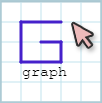5mm Graph Paper
This is a standard Cartesian system graphing paper. There are horizontal and vertical lines 5mm apart. Graph paper is often used in engineering, it's common to see engineering graph paper printed on light green paper. View details
1/4" Inch Graph Paper
Also know as Quad paper four boxes make up an inch. Sometimes it's also been referred to quadrille paper. The only difference between this an the other graph paper listed here is the size of the boxes. View details
Virtual Online Graph Paper
This virtual graph paper lets you draw lines and write text on it right from your computer. If you make a mistake you can easily undo it. It will remember what you draw unless you erase it so you don't have to worry about losing it. And to top it off it's printable. View details
10 Squares Per Inch Graph Paper
Working with inches? Having 10 squares per inch gives you a nice even number to work with that is both manageable and precise. View details
Dot Paper
Dot paper, or dotted paper is like graph paper. Only instead of lines there are dots. It's a good alternative to the more typical graph appear. Having dots instead of lines can be useful for designers. This kind of paper is also used in some games. View details
Centimeter Graph Paper
This is standard graph paper similiar to the graph paper above except of course the lines are 1 centimeter apart instead. View details
1/2" Half Inch Graph Paper
The half inch graph paper can handily function as a two dimensional ruler. View details
1" One-Inch Graph Paper
The larger size graph paper be useful when using the graph paper for measuring. Also when using it with underdeveloped motor skills, for example when working with children. It's also handy when giving presentations where the audience has to be able to see it from far away. View details
Isometric Graph Paper
This graph paper is used to draw three-dimensional figures. It has lines representing all three dimensions: length, width, and height. It can be used for isometric art, architectural designs, and plotting three-dimensional functions. Perfect for drawing sketches and drafting plans. View details
Log Graph Paper
Log is short for logarithmic, this graph paper is used to plot data where the values change exponentially. That is the values go up and down drastically very quickly. This graph paper has sections that compress large ranges of values allowing you to plot large and small numbers while still being able to see everything. View details
Polar Graph Paper
A traditional grid with horizontal and vertical lines is designed to plot Cartesian coordinates where a location is represented with a horizontal and vertical location. Polar coordinates represent another coordinate system where a location is specified by the angle and distance from a fixed point. This graph paper allows you to plot those points. View details
Looking for a particular paper size?
Are you looking for a particular size graph paper? Every type of graph paper we offer comes in different paper sizes and orientations. If you would like to see the graph paper listed by type you can go to one of these links:
What is Graph Paper?
Graph paper is paper meant to be written and drawn on. It is made of up fine lines arranged vertically and horizontally as to create many small boxes.
What is Graph Paper used for?
Graph paper is useful when you want to draw things to some kind of scale, instead of measuring each line with a ruler as you draw it you let the graph paper serve as a guide. Graph paper is available in many different measurements, for example each box can be centimeter or an inch in length.
For example anything using the cartesian system can make use of graph paper since the cartesian system is essentially a grid. This makes graph paper ideal for taking notes on math related subjects. For example to plot and study lines, functions, and data.
Other uses of graph paper:
You can use graph paper as a two dimensional ruler. Instead of placing the ruler on the object you can place the object on the paper.
You can also use it to do multi digit math. Having multiple numbers in a small space can make it confusing to determine which numbers should be added, subtracted, multiplied, etc. Graph papers keep those number neat and aligned.
It can also be used as a writing aid, specially for children learning to write. For example you can use a three block row. Capital letters can take up the top two rows. Lowercase letters should take up only the second row. Letters that dip under the line like the lowercase "p", "g", and "y" can take up the bottom two rows. Also a block can help children separate words which is helpful since children often have problems with spacing.
You can fill in blocks in black or color to create graph art.
You can use it to create crossword puzzles.
You can use it to create a maze.
You can use it to play the dot game with dots, this works when the grid lines are very light, that allows you to use a pen or pencil to darken them, also it helps if the grids are large.
Like it? Share it.
If you found this site useful can do me a favor and help others by sharing it? Thanks you.
